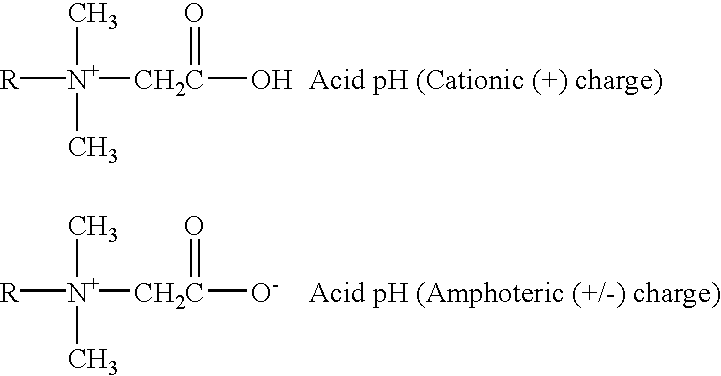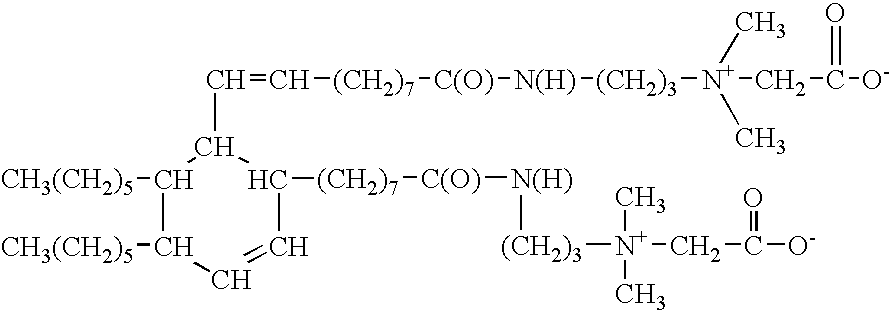Dimer amidopropyl dimethyl betaines
a technology of amidopropyl dimethyl betaine and amidopropyl dimethyl betaine, which is applied in the preparation of carboxylic acid amides, organic chemistry, fatty acid chemical modification, etc., can solve the problems of incompatibility between anionic and cationic surfactants, and achieves improved oxidative stability, efficient cleaning, and light color.
- Summary
- Abstract
- Description
- Claims
- Application Information
AI Technical Summary
Benefits of technology
Problems solved by technology
Method used
Image
Examples
example 1
Preparation of Dimer Amido Amine
[0028]To 561.0 grams if dimer acid is added 153.0 grams of dimethylaminopropyl amine. The mixture is heated to 180-200° C. and held for 3-8 hours. Once the temperature begins to reach 180° C., water begins to distill off. An excess of dimethylaminopropyl amine is added to speed up the reaction. When the acid value reaches 1.0 mg KOH / gram, the excess dimethylaminopropyl amine is stripped off by applying vacuum. The resulting product is the dimer amido amine useful as an intermediate in the preparation of the compounds of the present invention. The alkali value of the product so produced is 180.0 mg KOH / gm. The product is a yellow water insoluble liquid at ambient temperatures.
example 2
Preparation of Dimer Amido Amine
[0029]To 563.0 grams if hydrogenated dimer acid is added 153.0 grams of dimethylaminopropyl amine. The mixture is heated to 180-200° C. and held for 3-8 hours. Once the temperature begins to reach 180° C., water begins to distill off. An excess of dimethylaminopropyl amine is added to speed up the reaction. When the acid value reaches 1.0 mg KOH / gram, the excess dimethylaminopropyl amine is stripped off by applying vacuum. The resulting product is the dimer amido amine useful as an intermediate in the preparation of the compounds of the present invention. The alkali value of the product so produced is 180.0 mg KOH / gm.
example 3
Preparation of the Betaine of the Present Invention
[0030]Into a suitable reaction flask is charged 937.0 grams of de-ionized water. Next, add 238.0 grams of sodium chloro acetate. Heat is applied to 90° C. Next, 625.0 grams of dimer amidoamine (example 1) are charged into the reaction vessel under good agitation. The temperature is maintained at between 90° C. and 95° C., until the percentage of free tertiary amine is 0.5% maximum. During the reaction time, the pH is kept at between 7 and 8 with NaOH as required. The reaction mass will clear when the product is at 90 C for about 1 hour. The reaction time is approximately 6 to 9 hours. The % NaCl is monitored and the reaction is deemed complete when the % of theoretical NaCl reaches 98%.
[0031]The compound of the present invention is used without additional purification. It is a clear viscous liquid and is sold as an aqueous solution of between 30 and 40% solids by weight.
PUM
| Property | Measurement | Unit |
|---|---|---|
| Structure | aaaaa | aaaaa |
| Molecular weight | aaaaa | aaaaa |
Abstract
Description
Claims
Application Information
 Login to View More
Login to View More - R&D
- Intellectual Property
- Life Sciences
- Materials
- Tech Scout
- Unparalleled Data Quality
- Higher Quality Content
- 60% Fewer Hallucinations
Browse by: Latest US Patents, China's latest patents, Technical Efficacy Thesaurus, Application Domain, Technology Topic, Popular Technical Reports.
© 2025 PatSnap. All rights reserved.Legal|Privacy policy|Modern Slavery Act Transparency Statement|Sitemap|About US| Contact US: help@patsnap.com



